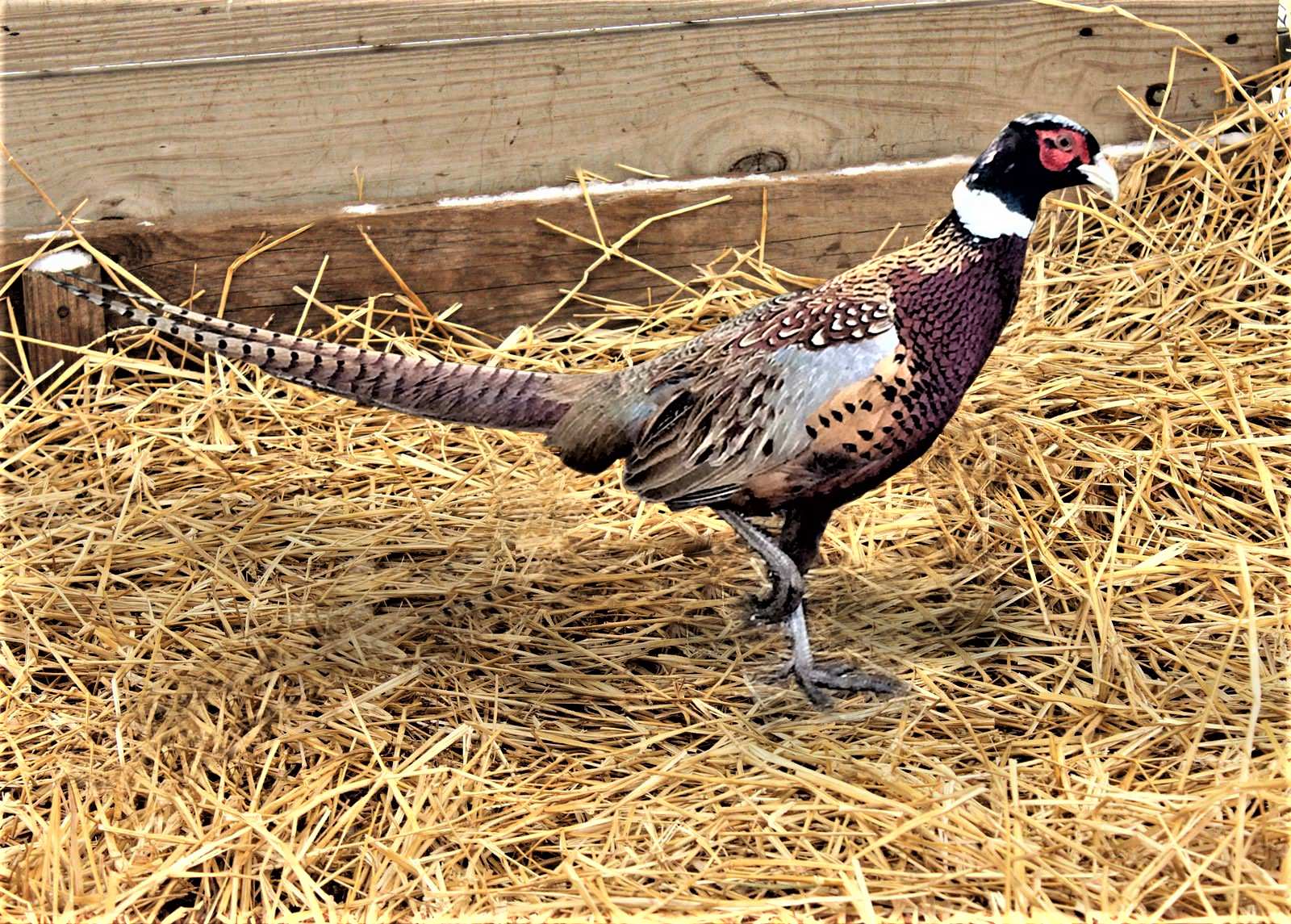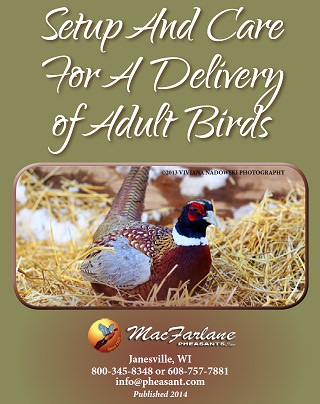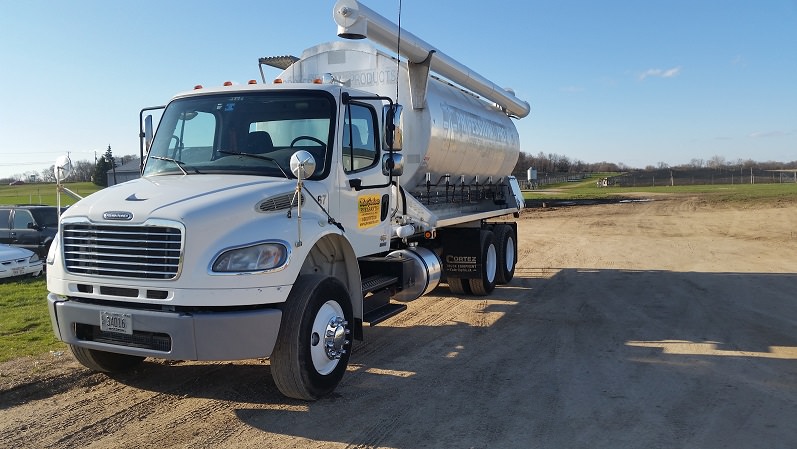Why Do Pheasants Pick?
Over the years I’ve heard lots of stories and rationalizations why pheasants pick. I am going to just lay out all the things I’ve heard and then give you my own theories. Pheasants cannibalize each other because they aren’t used to be penned up and captive. Pheasants can be the orneriest creatures – and in captivity, the strong tend to pick on the weak. Pheasant cocks are much more aggressive than hens, but hens can and will pick on each other.
The most obvious sign of picking is that pheasants have broken or missing feathers. When tails are just growing and are soft, pheasants often pick on the tail, taking a bite out of the young tail (which shows up as a chip or chunk of missing feather one the bird is grown). Sometimes the tail is just completely pulled out, it’s missing. Pheasants also pick on the wings of other pheasants (especially on the shoulders of topmost point of the wing). And pheasants pick the feathers out of the saddle or back feathers – eventually if its back enough the back picking will progress from a dime or nickel sized bare spot near the base of the tail to a much larger section of feathers on the back or saddle being entirely missing (and therefore the affected bird is bareback).
The most obvious reasons for picking are related to density (the number of birds in a given area) and the protein level and amino acid level of the feed, also the amount of feeder space allocated to the birds. Other factors that can affect picking are the breed of genetics of the pheasant you are raising, the amount of vegetative cover in the pen, the ability of birds to get away from other birds (roosts or heavy cover), weather (hot is bad), stresses on the birds, and list can go on.
I’ve heard people express that their solution to picking is to put out salt blocks in the pens, to make sure the feed has meat and bone meal in the feed, mist the birds. Most of these types of solutions are offered by people who are just rationalizing, trying to fit more birds into a pen that is too small.
What we have found here at our farm is that we need to provide our birds with adequate space, a balanced researched feed formulation, adequate feeder space and cover. If birds have had a traumatic event (such as a ventilation failure in a barn), then those birds will need extra space and better feed than “normal” birds. We also know from firsthand experience that some breeds of pheasants are more aggressive than others – and that some breeds of pheasants can be raised at higher densities than other breeds.
Here are some of our criteria. Early in the season (early May as an example) when we have 6 week old pheasants going into pens – our cover is just inches tall and therefore we must give our birds exorbitant space – both to keep the birds from picking, but also to allow the cover to continue to grow with the birds in the pens. So our birds early on get 45 sq ft per bird for cocks and 35 sq ft per bird for hens. Once our cover is up to knee high (or higher) we then combine our birds (the birds that were at 45 or 35 sq ft/bird) to 24 sq ft per cock and 18 sq ft per hen (we sex our birds when they go into the pens). Through the middle of the season we continue at those sq ft/bird – sometime going to 16 sq ft for hens and 22 sq ft for cox.
Feeder space is just as important as pen space. We allocate .7” of feeder space and .1” of waterer space per bird. I think one could get away with .6” of feeder space, but we have found .7” is better.
When we move out birds to the pens we put them on 20% grower. We switch the birds from 20% to 19% once the birds are 12 weeks old and it’s not over 80 degrees daily average temperature. So our early hatch birds often are on 20% til they are 20 weeks old, where is our August hatch birds go onto 19% right at 12 weeks.
To be clear, all of the feeds we purchase are formulated not just for protein level of course, but for amino acids, and all the other nutrients pheasants need. We do include meat and bone meal in our feeds for our ringneck pheasants, but we are using all vegetable based feed for our meat birds with no issues that we are aware of. So meat and bone meal does not need to be absolutely included – it’s not compulsory. There has been a not of hub bub about salt, and frankly I think it’s best to just follow one’s feed manufacturer’s advice. No, we don’t put salt blocks in our pens!!!
Something I nearly forgot to mention was peepers. We raise quite a few ringnecks without peepers and we must give those birds 60 sq ft even with excellent cover. There are a number of different peepers on the market – we prefer using peepers with pins as we don’t have many fall off and we can re-use the peepers. Clip-on peepers are fine, and you can ship quickly with them (as it’s faster to remove them). But you can’t re-use clip-ons and some of the clip-ons fall off. Some farms use hoods, but we feel that hoods quite significantly reduce the ability of pheasants to navigate and fly and run right at the time the hood is removed. With hoods, the birds take a few days after the hoods are removed to orient themselves – and that won’t work with many of our customers.
How does breeding (or genetics) affect picking?
There is a wide variation in the aggressiveness of pheasants between the different commercial game farms. Some farm’s birds don’t pick, but yet the birds are just too docile. For a strictly put and take market they may work – but we sell lot’s of birds to customers who want wild acting birds. There are other birds on the market that are much more cannibalistic, yet I don’t believe the birds fly any better or act any wilder. I feel our birds are not as aggressive as many other commercials farm’s strains yet our birds act as wild as any of our competitors. Our Manchurian pheasants are definitely less aggressive towards each other and wilder out in the field than any other pheasants available.
I feel I could keep going, but this is enough for now. Feel free to email me at bill@pheasant.com with any questions.
Related Posts

Preparing Our Barns & Pens Each Spring
Read Post

Our Milton Farm in 2024!
Read Post

10 Steps to Prepare for a Delivery of Mature Game Birds
Read Post

4 Steps to Keeping Pheasants Healthy in Winter
Read Post

6 Feed and Water Procedures to Keep MacFarlane Pheasants Healthy
Read Post

Can Goats Be Helpful on a Pheasant Farm?
Read Post

Catching Mature Pheasants
Read Post

Choosing the Right Type of Game Bird
Read Post
Take Advantage of These Free Resources
As the biggest game bird farm in the United States, we want to share our experience with you. Download our free resources below and get started.





